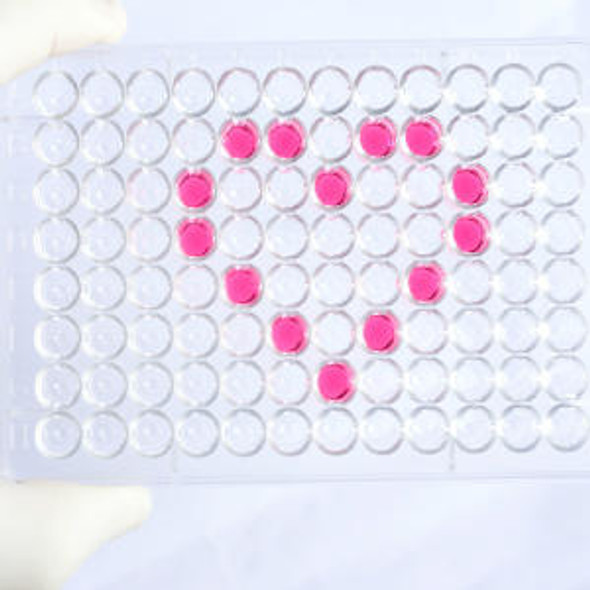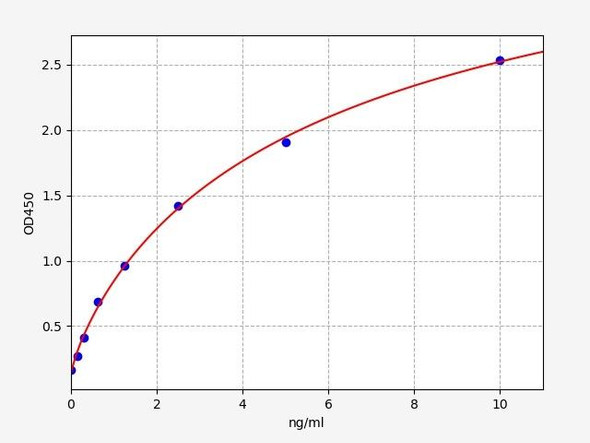Mouse Cell Signalling ELISA Kits 4
Mouse Cytosolic phospholipase A2 (Pla2g4a) ELISA Kit
- SKU:
- MOEB1567
- Product Type:
- ELISA Kit
- Size:
- 96 Assays
- Uniprot:
- P47713
- ELISA Type:
- Sandwich
- Synonyms:
- cPLA2, PLA2G4A, Cytosolic phospholipase A2
- Reactivity:
- Mouse
Description
| Product Name: | Mouse Cytosolic phospholipase A2 (Pla2g4a) ELISA Kit |
| Product Code: | MOEB1567 |
| Alias: | Cytosolic phospholipase A2, cPLA2, Phospholipase A2 group IVA, Pla2g4a, Cpla2, Pla2g4 |
| Uniprot: | P47713 |
| Reactivity: | Mouse |
| Range: | Please contact us for more information |
| Detection Method: | Sandwich |
| Size: | 96 Assay |
| Storage: | Please see kit components below for exact storage details |
| Note: | For research use only |
| UniProt Protein Function: | cPLA2: a calcium-dependent phospholipase A2 that catalyzes the release of arachidonic acid from membrane phospholipids. Selectively hydrolyzes arachidonyl phospholipids in the sn-2 position releasing arachidonic acid. Arachidonic acid is a precursor for the eicosanoids that are involved in hemodynamic regulation, inflammatory responses, and other cellular processes. Promotes cerebellar long-term depression and motor learning. Translocates to the Golgi and endoplasmic reticulum in a calcium-dependent fashion. Translocation and activation of at the ER facilitates the process of ER stress. Regulates the biogenesis of lipid droplets, a process dependent on JNK and ceramide kinase. Stimulated by agonists such as ATP, EGF, thrombin and bradykinin as well as by cytosolic Ca2+. The N-terminal C2 domain, by its association with lipid membranes, mediates the regulation of CPLA2 by presenting the active site to its substrate in response to elevations of cytosolic Ca2+. Inhibited when in trimolecular complex with ANXA2 and S100A10. Phosphorylation of S727 relieves this inhibitory interaction, thus activating PLA2G4A. |
| UniProt Protein Details: | Protein type:Lipid Metabolism - linoleic acid; Lipid Metabolism - arachidonic acid; Lipid Metabolism - ether lipid; Lipid Metabolism - alpha-linolenic acid; Phospholipase; EC 3.1.1.4; Lipid Metabolism - glycerophospholipid; EC 3.1.1.5 Cellular Component: cytoplasm; cytoplasmic vesicle; cytosol; endoplasmic reticulum; Golgi apparatus; intracellular membrane-bound organelle; nucleus; perinuclear region of cytoplasm Molecular Function:calcium ion binding; calcium-dependent phospholipase A2 activity; calcium-dependent phospholipid binding; histone acetyltransferase binding; hydrolase activity; lysophospholipase activity; metal ion binding; phospholipase A2 activity; phospholipase activity Biological Process: arachidonic acid metabolic process; arachidonic acid secretion; decidualization; icosanoid biosynthetic process; lipid catabolic process; lipid metabolic process; metabolic process; ovulation from ovarian follicle; phospholipid catabolic process; positive regulation of apoptosis; positive regulation of cell proliferation; positive regulation of inflammatory response; positive regulation of prostaglandin biosynthetic process; positive regulation of vesicle fusion; regulation of cell proliferation; response to calcium ion; response to organic substance; surfactant homeostasis |
| NCBI Summary: | The protein encoded by this gene is a member of the phospholipase A2 group IV family. This enzyme hydrolyzes membrane phospholipids, thereby releasing the polyunsaturated fatty acid, arachidonic acid. Arachidonic acid is further metabolized into eicosanoids such as leukotrienes, thromboxanes and prostaglandins, that play important roles in regulating diverse biological processes such as inflammatory responses, membrane and actin dynamics, and tumorigenesis. A rise in intracellular calcium levels results in binding of calcium to the C2 domain of this protein, and triggers the translocation from the cytosol to intracellular membranes, including the Golgi apparatus. Disruption of this gene in mice led to decreased levels of eicosonaoids and platelet-activating factor, decreased allergic symptoms, and impaired reproductive ability in females. Alternative splicing results in multiple transcript variants encoding different isoforms. [provided by RefSeq, Mar 2015] |
| UniProt Code: | P47713 |
| NCBI GenInfo Identifier: | 6679369 |
| NCBI Gene ID: | 18783 |
| NCBI Accession: | NP_032895.1 |
| UniProt Related Accession: | P47713 |
| Molecular Weight: | 85,222 Da |
| NCBI Full Name: | cytosolic phospholipase A2 isoform 1 |
| NCBI Synonym Full Names: | phospholipase A2, group IVA (cytosolic, calcium-dependent) |
| NCBI Official Symbol: | Pla2g4a |
| NCBI Official Synonym Symbols: | cPLA2; Pla2g4; cPLA2alpha; cPLA2-alpha |
| NCBI Protein Information: | cytosolic phospholipase A2 |
| UniProt Protein Name: | Cytosolic phospholipase A2 |
| UniProt Synonym Protein Names: | Phospholipase A2 group IVAIncluding the following 2 domains:Phospholipase A2 (EC:3.1.1.4)Alternative name(s):Phosphatidylcholine 2-acylhydrolase |
| Protein Family: | Cytosolic phospholipase |
| UniProt Gene Name: | Pla2g4a |
| UniProt Entry Name: | PA24A_MOUSE |
| Component | Quantity (96 Assays) | Storage |
| ELISA Microplate (Dismountable) | 8×12 strips | -20°C |
| Lyophilized Standard | 2 | -20°C |
| Sample Diluent | 20ml | -20°C |
| Assay Diluent A | 10mL | -20°C |
| Assay Diluent B | 10mL | -20°C |
| Detection Reagent A | 120µL | -20°C |
| Detection Reagent B | 120µL | -20°C |
| Wash Buffer | 30mL | 4°C |
| Substrate | 10mL | 4°C |
| Stop Solution | 10mL | 4°C |
| Plate Sealer | 5 | - |
Other materials and equipment required:
- Microplate reader with 450 nm wavelength filter
- Multichannel Pipette, Pipette, microcentrifuge tubes and disposable pipette tips
- Incubator
- Deionized or distilled water
- Absorbent paper
- Buffer resevoir
*Note: The below protocol is a sample protocol. Protocols are specific to each batch/lot. For the correct instructions please follow the protocol included in your kit.
Allow all reagents to reach room temperature (Please do not dissolve the reagents at 37°C directly). All the reagents should be mixed thoroughly by gently swirling before pipetting. Avoid foaming. Keep appropriate numbers of strips for 1 experiment and remove extra strips from microtiter plate. Removed strips should be resealed and stored at -20°C until the kits expiry date. Prepare all reagents, working standards and samples as directed in the previous sections. Please predict the concentration before assaying. If values for these are not within the range of the standard curve, users must determine the optimal sample dilutions for their experiments. We recommend running all samples in duplicate.
| Step | |
| 1. | Add Sample: Add 100µL of Standard, Blank, or Sample per well. The blank well is added with Sample diluent. Solutions are added to the bottom of micro ELISA plate well, avoid inside wall touching and foaming as possible. Mix it gently. Cover the plate with sealer we provided. Incubate for 120 minutes at 37°C. |
| 2. | Remove the liquid from each well, don't wash. Add 100µL of Detection Reagent A working solution to each well. Cover with the Plate sealer. Gently tap the plate to ensure thorough mixing. Incubate for 1 hour at 37°C. Note: if Detection Reagent A appears cloudy warm to room temperature until solution is uniform. |
| 3. | Aspirate each well and wash, repeating the process three times. Wash by filling each well with Wash Buffer (approximately 400µL) (a squirt bottle, multi-channel pipette,manifold dispenser or automated washer are needed). Complete removal of liquid at each step is essential. After the last wash, completely remove remaining Wash Buffer by aspirating or decanting. Invert the plate and pat it against thick clean absorbent paper. |
| 4. | Add 100µL of Detection Reagent B working solution to each well. Cover with the Plate sealer. Incubate for 60 minutes at 37°C. |
| 5. | Repeat the wash process for five times as conducted in step 3. |
| 6. | Add 90µL of Substrate Solution to each well. Cover with a new Plate sealer and incubate for 10-20 minutes at 37°C. Protect the plate from light. The reaction time can be shortened or extended according to the actual color change, but this should not exceed more than 30 minutes. When apparent gradient appears in standard wells, user should terminatethe reaction. |
| 7. | Add 50µL of Stop Solution to each well. If color change does not appear uniform, gently tap the plate to ensure thorough mixing. |
| 8. | Determine the optical density (OD value) of each well at once, using a micro-plate reader set to 450 nm. User should open the micro-plate reader in advance, preheat the instrument, and set the testing parameters. |
| 9. | After experiment, store all reagents according to the specified storage temperature respectively until their expiry. |
When carrying out an ELISA assay it is important to prepare your samples in order to achieve the best possible results. Below we have a list of procedures for the preparation of samples for different sample types.
| Sample Type | Protocol |
| Serum | If using serum separator tubes, allow samples to clot for 30 minutes at room temperature. Centrifuge for 10 minutes at 1,000x g. Collect the serum fraction and assay promptly or aliquot and store the samples at -80°C. Avoid multiple freeze-thaw cycles. If serum separator tubes are not being used, allow samples to clot overnight at 2-8°C. Centrifuge for 10 minutes at 1,000x g. Remove serum and assay promptly or aliquot and store the samples at -80°C. Avoid multiple freeze-thaw cycles. |
| Plasma | Collect plasma using EDTA or heparin as an anticoagulant. Centrifuge samples at 4°C for 15 mins at 1000 × g within 30 mins of collection. Collect the plasma fraction and assay promptly or aliquot and store the samples at -80°C. Avoid multiple freeze-thaw cycles. Note: Over haemolysed samples are not suitable for use with this kit. |
| Urine & Cerebrospinal Fluid | Collect the urine (mid-stream) in a sterile container, centrifuge for 20 mins at 2000-3000 rpm. Remove supernatant and assay immediately. If any precipitation is detected, repeat the centrifugation step. A similar protocol can be used for cerebrospinal fluid. |
| Cell culture supernatant | Collect the cell culture media by pipette, followed by centrifugation at 4°C for 20 mins at 1500 rpm. Collect the clear supernatant and assay immediately. |
| Cell lysates | Solubilize cells in lysis buffer and allow to sit on ice for 30 minutes. Centrifuge tubes at 14,000 x g for 5 minutes to remove insoluble material. Aliquot the supernatant into a new tube and discard the remaining whole cell extract. Quantify total protein concentration using a total protein assay. Assay immediately or aliquot and store at ≤ -20 °C. |
| Tissue homogenates | The preparation of tissue homogenates will vary depending upon tissue type. Rinse tissue with 1X PBS to remove excess blood & homogenize in 20ml of 1X PBS (including protease inhibitors) and store overnight at ≤ -20°C. Two freeze-thaw cycles are required to break the cell membranes. To further disrupt the cell membranes you can sonicate the samples. Centrifuge homogenates for 5 mins at 5000xg. Remove the supernatant and assay immediately or aliquot and store at -20°C or -80°C. |
| Tissue lysates | Rinse tissue with PBS, cut into 1-2 mm pieces, and homogenize with a tissue homogenizer in PBS. Add an equal volume of RIPA buffer containing protease inhibitors and lyse tissues at room temperature for 30 minutes with gentle agitation. Centrifuge to remove debris. Quantify total protein concentration using a total protein assay. Assay immediately or aliquot and store at ≤ -20 °C. |
| Breast Milk | Collect milk samples and centrifuge at 10,000 x g for 60 min at 4°C. Aliquot the supernatant and assay. For long term use, store samples at -80°C. Minimize freeze/thaw cycles. |






